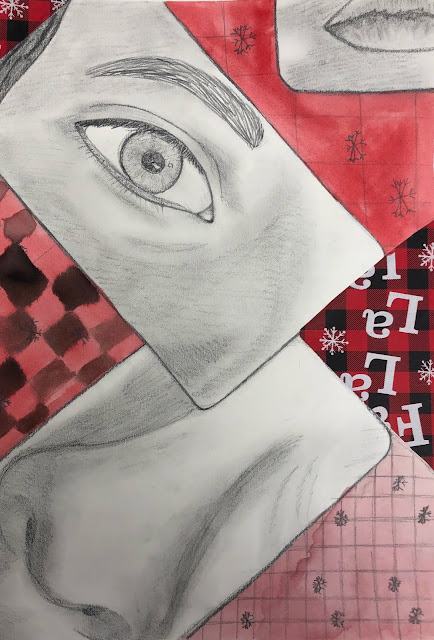Your final assignment for SA 111 will turn the lens onto you!
1. There are three parts to this assignment
2. Each one should be fully developed to the best of the student's ability
3. Your drawings should illustrate advancement in your skill throughout the semester
4. Your drawings should also illustrate creative activity, excellent time management, evolution of the assignment fully displayed in your sketchbook and full engagement on your part
Part ONE
In your Sketchbooks
Graphite on paper compose your eye, nose, mouth
- Capture the values of the surrounding area
- Use a full value range
- Make use of your pencil marks following a planar analysis of each of your features
- Remember each feature is surround by an area of your face
Part TWO
Graphite
Watercolor Paper
A patterned piece of paper (origami/wrapping paper) or fabric
- Make use of a handheld mirror as your viewfinder
- Compose a number of your facial features - first in your sketchbook
- Experiment with the scale of your facial features and mirror outline
- Look intensely at each feature and develop a full value range
- In the negative space draw the pattern you have brought in
Arrange in such a way to develop an interesting play on its scale too
- Using watercolors/stains and full opacity of color paint the local color of this patterned area in the drawing
Part THREE
Strathmore #140 paper
Reaves BFK paper
Arches #140 paper
Watercolor paper
Paper size smallest edge 20"
Papers are sold separately in the Bookstore in the black flat files in the back of the shop
Alternative Self Portraits
What do creative self-portraits express about the artist?
- Self-portraits allow the artist to practice both their drawing and compositional skills
- Self-portraits can express different expressions and moods reflective of the artist
- Self-portraits can preserve a memory
- Self-portraiture requires self-exploration in order for the artist to make the best decisions to how they wish to represent themselves
Expression, gesture, clothing, spatial conditions, texture, media, color, mark making, expressionistic style will collectively reveal what you wish to convey to your audience, emotion, gesture, etc.
The question thus becomes, what do you want to say about yourself?
Media on rag paper:
Make use of the media we have used in class including graphite, charcoal, Conte crayon, pastel, collage, watercolor, ink -- it is your choice and may be a combination of these media
Make a Mind Map of what makes you You in your sketchbook
A mind map is a diagram used to represent words, concepts, images, tasks, etc. that link and spread radially around a centralized theme. Mind maps are used to generate ideas and visualizations, structure and to ultimately clarify and classify ideas.
Ours will be I D E N T I T Y
Think about your values, your inspirations, your traditions, customs, ethnicity, friends/family, your interests, your appearance, how you like to spend your free time, etc.
Ours will be I D E N T I T Y
Think about your values, your inspirations, your traditions, customs, ethnicity, friends/family, your interests, your appearance, how you like to spend your free time, etc.
1. Create a preliminary mind map of your goals, influences, aspirations, interests, personality, etc. in your sketchbook to plan your ideas for Part ONE of your final project
2. Use a minimum of five large branches, each having 3 smaller branches each
3. Try to visualize what each concept will be illustratively
Part THREE, the drawing...
Develop an alternative self-portrait that exemplifies you and the many things that create your unique personality
Your drawings should show the following:
- A full value range
- Developed volumes and masses through full value range
- The direction of light falling onto objects
- Local color as well as optical color
- 3/4 of your face needs to be included (minimum)
- 3/4 of your face needs to be included (minimum)



























